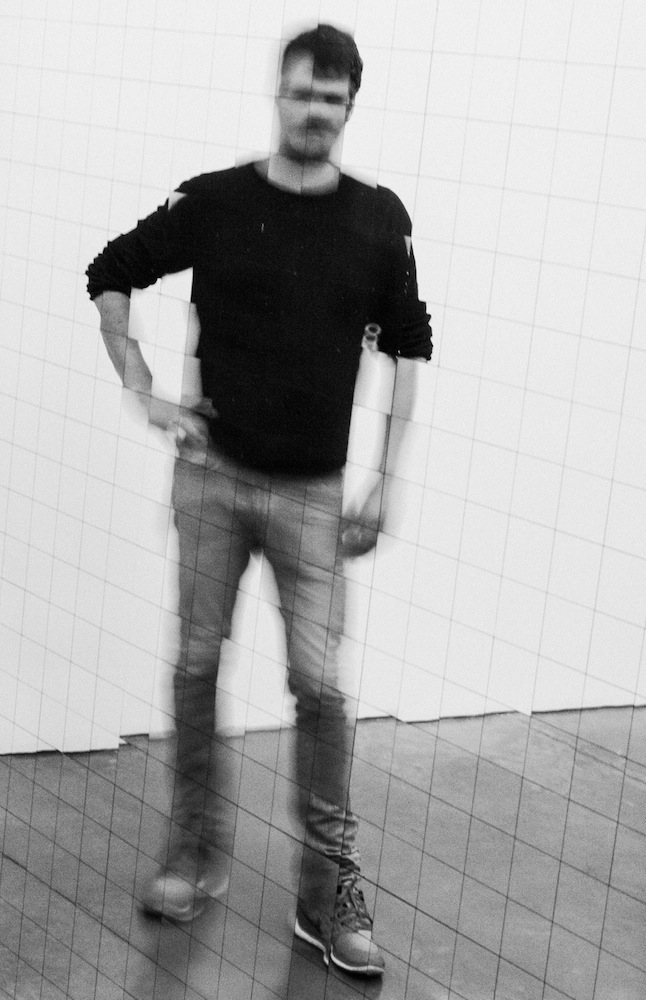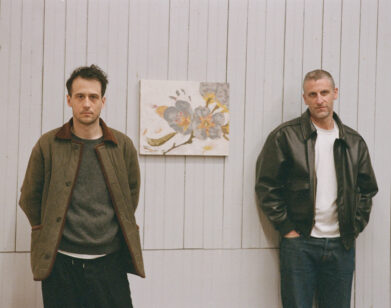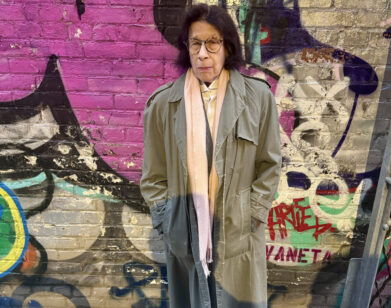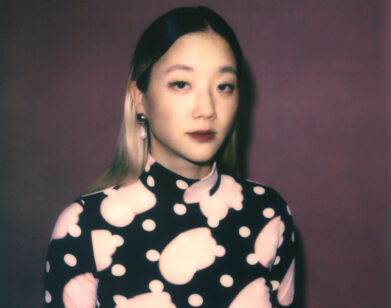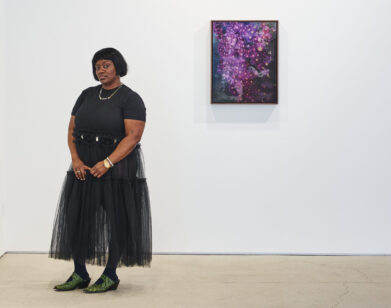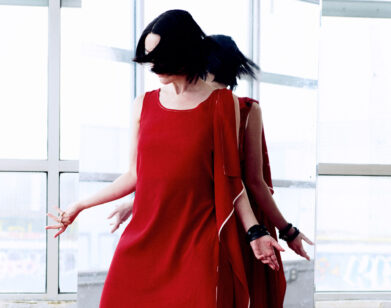The Art of Machines
RANDOM INTERNATIONAL IN NEW YORK, SEPTEMBER 2016. PHOTOS: MARK DAVIS.
Since 2005, artist collective Random International has created works that blend art and science, with the goal of making participants more aware of the way our bodies interact with and identify machines. Pieces such as 2012’s Rain Room—which fills a dark room with continuous, responsive rain—draw audiences into enchanting yet fleeting digital experiences that challenge the permanence of day-to-day existence. Like Rain Room (which has since traveled to New York, Shanghai, and Los Angeles), their art often spreads to the masses via social media, in some ways turning visitors into the subjects of the work itself.
Hannes Koch and Florian Ortkrass were both born in Germany but founded Random International after meeting at graduate school in London. At their studios in both London and Berlin, they create interactive works like Temporary Graffiti (2005), where visitors paint with light, or Audience (2008), which surrounds the subject with small mirrors that move in unison by sensing one’s presence. To further develop their practice after the massive success of Rain Room, Random International embarked on a residence in the biomimetic robotics division at Harvard University, the result of which is new work currently on view at Pace Gallery’s 24th Street location in New York (another exhibition will follow at Pace’s Art + Technology space in Menlo Park next year). Titled “On The Body,” the current show includes the life-size, robotic piece Fifteen Points / I, and continues the duo’s examination of artificial intelligence and the relationship between man and machine.
Here, Koch and Ortkrass discuss their first exhibition with Pace and how they’ve arrived at this new body of work.
CEDAR PASORI: How did you both become interested in this union of art and technology?
FLORIAN ORTKRASS: We have a shared fascination with how things work, mainly in nature—how very complex systems function and how all of them are in equilibrium. Lately we’re interested in how we as humans make our own systems. It all comes down to how we see our world and live in it, or against it, and how each of us is able to maneuver it. Our research is focused on how we understand things, how we see movement, how we decipher gestures, and how our minds make sense of very limited information.
PASORI: What kind of artists and thinkers work in the Random International studio, and what kind of environment do you try to create?
ORTKRASS: We have quite a few designers from various disciplines. We have design engineers, product designers, software engineers, electrical engineers, mechanical engineers, a fashion designer, and an art historian. What unites us all is our attention to detail. We have the privilege of being very instinctual and interest-driven; we’re able to follow our impulses.
HANNES KOCH: Our goal is that the people in our studio feel their passion being respected to the highest possible level. We like to keep a seriousness in our discourse without being stuck-up. It’s usually a very humorous setting. The people we work with have a lot of ambition to realize themselves through the work we do as a studio, and there’s enormous pride for it. It’s extremely rewarding to come back to everyday.
PASORI: How did you start doing “Symposia” at the studio, and what is their purpose?
KOCH: After creating both two and three-dimensional installations involving the body for a few years, we wanted to learn more about what’s happening when people see and experience our work. The overarching theme in our work right now and in recent “Symposia” is the man-machine relationship. The next “Symposia” is titled “On the Body,” so we have genetic scientists, choreographers, and biological motion experts coming to speak with the studio. The “Symposia” are meant to help us refine our work and extend our artistic vocabulary.
PASORI: Let’s talk about the Rain Room at LACMA. What does it mean for you to have the installation at the museum, given the history of the Art + Technology program that existed in the ’60s?
KOCH: We learned about the program only five or six years ago, so it wasn’t present in our educational landscape. We are intrigued by the incredible breadth of it—finding out how artists have been working with technology long before the digital age in a very natural manner. We enjoyed reading the Art + Technology concept proposals, especially some of the unrealized ones. This artistic thinking was groundbreaking back then.
Being able to show our work in that context is a big deal for us. It’s a homecoming, in a way. It’s not tech-art or any other weird compartmentalization anymore. It’s confidently presented at LACMA. You look at people like Robert Irwin and James Turrell—masters of our time. It’s just amazing. We’re honored.
PASORI: Now that Rain Room has been in a few different cities, sometimes simultaneously, what have you learned from its spread and reception globally?
ORTKRASS: People like rain much more than we thought! [laughs] When we opened the installation at the Barbican in London, it was very grim outside, and we had created this huge, pitch black, humid space with water falling from the ceiling. We looked at each other and thought that maybe no one would want to see it. It looked exactly how we wanted it to, but it was raining outside, too. For us, it’s still fascinating what happened from day one.
KOCH: I agree, it’s still fascinating to this day. After it was very successful in London, we didn’t think it would be very successful in New York, because of the impatience of New Yorkers. Then we thought that, in China, maybe they had already built three Rain Rooms before we arrived. In L.A., they have Hollywood and the film industry, so maybe they’d think Rain Room is very last century or something. There’s something about the physicality and the way it’s presented that still seems to touch people. It’s something we’re still experiencing ourselves, and that’s what keeps it interesting, too.
PASORI: For many people, it is ultimately a beautiful experience, whether they’re conscious of the fact that it is an experience provided by machinery.
KOCH: For us, it’s still interesting to have a non-judgemental debate over whether people feel fooled by it. After all, it is a machine, as you say. We’ve been asking ourselves, are visitors experiencing genuine emotions, or is it just a moment through Facebook that doesn’t last? When does the simulation of it become real? This leads to artificial intelligence, when something simulated becomes real life.
ORTKRASS: Basically, how real does the rain have to be?
KOCH: Not at all, it turns out.
PASORI: In the vein of reflection and introspection, you have an ongoing partnership with Le Laboratoire at Harvard that started after Rain Room began. How are works developed from that residency, like Fifteen Points / I and 150 Milliseconds, different from your work so far?
KOCH: We met David Edwards, the founder of Le Laboratoire, when he came to visit the Rain Room in London. He’d seen earlier works like Swarm Studies, involving bio-robotic bees. He asked if we’d be interested in doing a residency at Harvard, and we immediately said yes.
We then developed a format for a residency. Since we have a big studio, it’s not easy. We went to Harvard at different times for 10 days each. It was a very open-ended format, no strings attached. There was no timeline attached to it. All of this fueled incredibly exciting, open discussion with Robert Howie’s post-doc students at Harvard. From that we developed a whole new vocabulary.
The final outcome that we’ll present with Pace gallery in September is a new piece, Fifteen Points / I. We exhibited Fifteen Points / I “in process” at Le Lab—how we come to certain aesthetic decisions, how we come to certain technical conclusions. We had never shown our work that way before. It felt really good to present and celebrate the level of detail that goes into certain parts of the work.
ORTKRASS: If you think about man and machine inhabiting the same space, it’s a mutually interesting thing for people on the engineering side of robotics. How can people work next to machines in a very physical way? That’s still the frontier of robotics at the moment. There was instantly interest in how we look at that, and how engineering looks at that, in terms of solving problems and identifying interesting areas.
PASORI: What’s the significance of the numeric values in Fifteen Points / I and 150 Milliseconds?
KOCH: “15 points” constitutes the minimal amount of information that a human requires to recognize movement as biological motion. Dr. Nikolaus Troje placed 15 tracking markers on people and studied how they move, finding enormous amounts of information from these 15 points: gender, mood, body weight, and so on.
150 milliseconds is the maximum amount of time it takes anyone on this planet to recognize movement as biological motion. There are evolutionarily reasons that help us to distinguish a tiger from moving leaves.
ORTKRASS: The brain is trained to make sense out of objects moving to distinguish if it’s a person or not a person. You can say, “That’s a human body moving,” within 150 milliseconds. Then when you go to scramble the information, you know if it’s something that’s alive or not alive, the direction it moves, etcetera.
KOCH: For the eventual result of Fifteen Points / I, we built an incredibly complex convolution of robotic arms to precisely move 15 light points. How much do we focus on the clutter, and how much are we able to make sense of those 15 light points, which are the essence of the humanity of human movement? Can these machines pretend to be male or female? The large sculpture will be human-sized and slide on 12-meter long rails. The piece is about the moment we recognize a machine as having inherently human qualities—what happens in our minds in that moment. A machine can go from male to female and then back to something completely abstract. We’re going to experience that more and more in our lives in the next 20 to 50 years. It really does something to you when something so natural suddenly changes into something outright unnatural. The emotional impact of that on us is something we are trying to study here.
PASORI: What else can you share about joining Pace Gallery and their Art + Technology program?
KOCH: It’s an incredible association. They’ve been working with [James] Turrell and [Robert] Irwin for decades. It’s fantastic that a gallery like Pace goes out and takes a stance for the roots and origins of the movement and sees us as part of it. They are extremely scientifically minded and open to experimentation. They’ve also given us the opportunity to present this work in Silicon Valley next year, where a lot of these discussions are currently being had by incredibly talented people, but not necessarily so many artists among them. It’s an honor that we can bring our perspective and criticism into that arena.
PASORI: Do you feel that art is generally an overlooked entry point for understanding our relationship with machines?
ORTKRASS: There should be more discussions about things that are happening on a level that exists in the present—new things today that use AI—in order to talk about where it’s going. We were talking to someone in Cambridge, and he said that there used to be machines that people would build, and not a single person would understand how the whole thing functions. We now have machines that do a lot of the thinking and decision-making. Even as a group, if something goes wrong, or if a machine makes a certain decision, we don’t know the basis that decision is made from.
At the moment, there’s very little public discussion. People talk about driverless cars, but not where all of it is leading, how it actually works, and where the dangers are. It’s seen as a technical development that we just need to push further, and everything will be fine in the end. To comment on that and create more public debate, if we manage to, would be fantastic.
KOCH: It’s always problematic to have art with a function, to use art to communicate this or that. We’re using art as an excuse to share these thoughts and concerns. We make the work to understand our concerns better, through exploring the implications. Showing it in both New York and the heartbeat of where the man-machine relationship currently sits is special. What it hopefully brings is a certain sensibility for these topics, away from the mechanistic and rational into the emotionally instinctive realm.
“ON THE BODY” WILL BE ON VIEW AT PACE GALLERY’S 24TH STREET LOCATION IN NEW YORK THROUGH OCTOBER 21, 2016. FOR MORE ON RANDOM INTERNATIONAL, VISIT THEIR WEBSITE.

